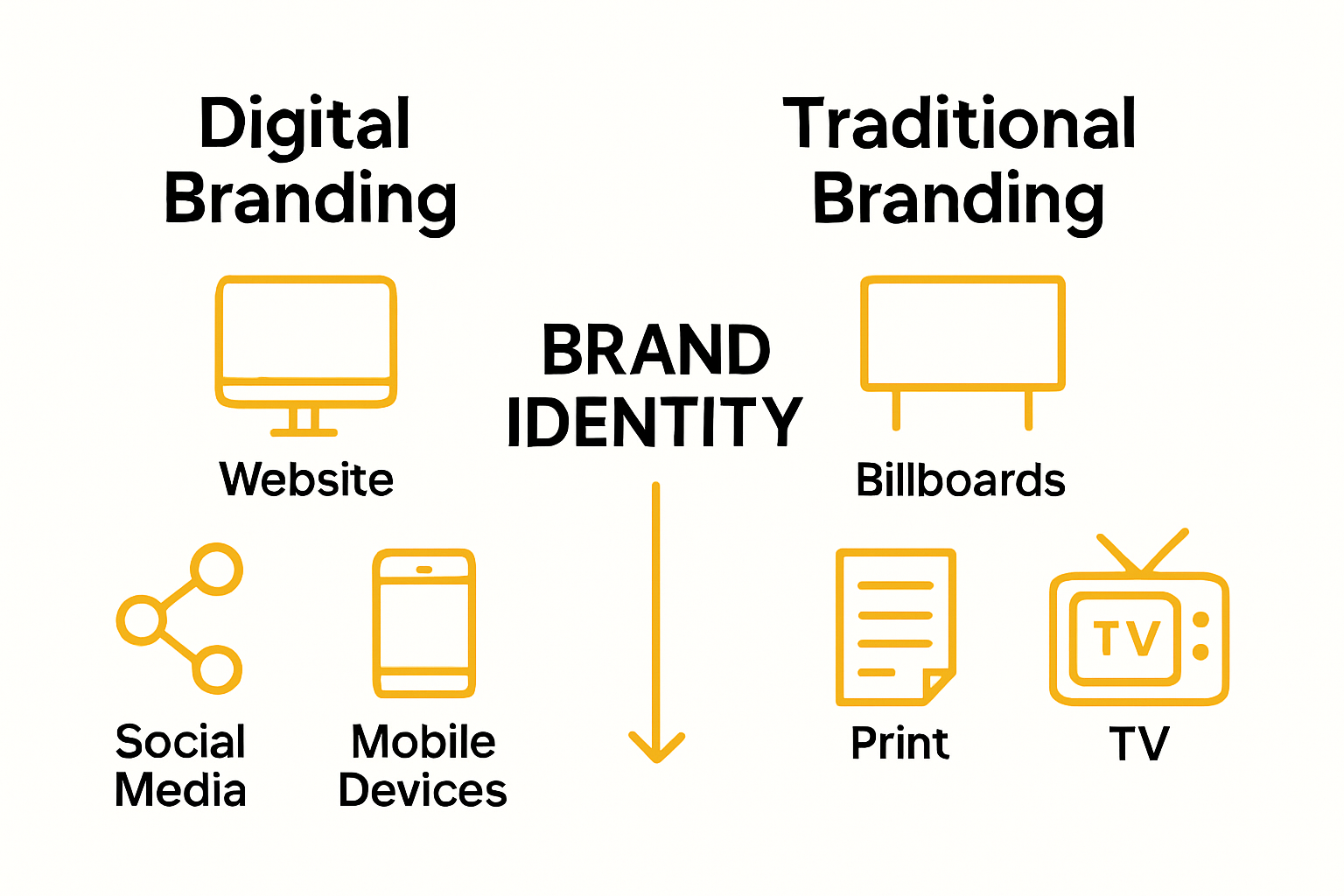What is Digital Branding? A Comprehensive Explanation
- Eddie The Chef

- Sep 14
- 8 min read

Digital branding is changing how Aussies see and connect with businesses online. A staggering 68 percent of customers judge a business’s credibility based solely on its website’s design and digital presence. Most people think it’s all about logos and colours but there’s something bigger at play. The real power comes from how brands use storytelling and genuine interaction to build real trust and loyalty in a crowded digital world.
Table of Contents
Quick Summary
Takeaway | Explanation |
Digital branding builds authentic connections. | Focus on creating genuine relationships with audiences to foster trust and engagement. |
Consistency is key in visual identity. | Maintain a uniform design language across all digital platforms to reinforce recognition. |
Authentic storytelling enhances brand perception. | Share meaningful narratives that reflect true values and engage customers emotionally. |
Customer trust is the currency of digital brands. | Develop a cohesive online presence to signal professionalism and reliability to customers. |
User experience shapes digital interaction. | Ensure all digital interfaces are functional and engaging to create memorable experiences for users. |
Defining Digital Branding: Core Concepts and Meaning
Digital branding represents the strategic approach businesses use to establish and communicate their unique identity across online platforms. Unlike traditional branding, digital branding focuses on creating meaningful connections with audiences through digital channels, leveraging technology to craft compelling narratives and experiences.

The Fundamental Essence of Digital Branding
At its core, digital branding is about translating a company’s fundamental values, personality, and promise into digital experiences that resonate with target audiences. This involves more than simply having an online presence it requires thoughtful integration of visual design, messaging, user experience, and strategic communication across multiple digital touchpoints.
According to La Trobe University’s Digital Marketing Research, digital branding encompasses several critical elements:
Consistent visual identity across digital platforms
Authentic storytelling through digital content
Interactive engagement strategies
Strategic use of multimedia and interactive experiences
Building Digital Brand Authenticity
Authenticity becomes paramount in digital branding. Businesses must create genuine connections that transcend traditional marketing approaches. This means developing content that reflects true organisational values, demonstrates expertise, and provides real value to the audience.
Successful digital branding transforms websites, social media profiles, email communications, and online interactions into powerful storytelling platforms. It’s about creating a cohesive digital ecosystem where every interaction reinforces the brand’s unique personality and value proposition.
The ultimate goal of digital branding is to build trust, recognition, and emotional connection with audiences in an increasingly digital world. By strategically crafting digital experiences that are memorable, relevant, and aligned with audience expectations, businesses can differentiate themselves and create lasting impressions that drive engagement and loyalty.
The Importance of Digital Branding for Businesses
Digital branding has transformed from a competitive advantage to a critical necessity for businesses seeking sustainable growth and market relevance. In an increasingly connected world, how a company presents itself online directly impacts its ability to attract, engage, and retain customers.
Establishing Competitive Differentiation
Businesses today operate in a digital ecosystem where standing out requires more than traditional marketing techniques. Digital branding enables companies to create unique, memorable identities that distinguish them from competitors. This goes beyond visual aesthetics to communicate core values, expertise, and distinctive service propositions.
According to Queensland Government Business Resources, effective digital branding allows businesses to:
Share compelling brand narratives
Create consistent visual personalities
Build trust through transparent communication
Demonstrate industry leadership
Building Customer Trust and Credibility
In the digital realm, trust is the most valuable currency. Customers increasingly research businesses online before making purchasing decisions. A robust digital brand signals professionalism, reliability, and commitment to customer experience. This means developing a cohesive online presence that reflects your business’s core values and delivers consistent messaging across all digital platforms.
Strategic digital branding helps businesses communicate authenticity by showcasing genuine customer experiences, sharing behind-the-scenes insights, and providing valuable content that addresses audience needs. When businesses invest in creating meaningful digital connections, they transform transactional relationships into long-term brand loyalty.

The power of digital branding extends beyond immediate sales it builds lasting reputation, influences customer perceptions, and creates sustainable competitive advantages in an ever-evolving digital marketplace. By thoughtfully crafting their online identity, businesses can turn digital platforms into powerful tools for growth, engagement, and meaningful customer connections.
How Digital Branding Influences Customer Perception
Customer perception represents a complex psychological process where individuals interpret and understand a brand through multiple digital interactions and touchpoints. Digital branding acts as a powerful mechanism that shapes these perceptions, transforming how customers view and engage with businesses in an increasingly connected marketplace.
Psychological Dimensions of Digital Brand Perception
Customers form impressions about businesses within seconds of digital interaction. These rapid assessments are influenced by visual design, messaging consistency, user experience, and the overall narrative communicated through digital platforms. Digital branding becomes a strategic tool for managing these critical first impressions and guiding customer interpretations.
According to University of Southern Queensland Research, customer perceptions are shaped by several key psychological factors:
Brand visual consistency
Emotional storytelling
Perceived authenticity
Digital interaction quality
Brand responsiveness
Trust and Emotional Connection Mechanisms
Digital branding transcends visual aesthetics by creating emotional connections that influence customer trust and loyalty. Businesses that demonstrate genuine values, transparent communication, and consistent digital experiences can transform passive observers into engaged brand advocates.
The strategic use of digital storytelling, personalised content, and responsive communication channels enables businesses to humanise their brand. By showcasing real experiences, sharing behind-the-scenes insights, and actively engaging with audiences, companies can build meaningful connections that go beyond transactional relationships.
Ultimately, digital branding serves as a sophisticated psychological tool that guides customer perceptions, builds emotional resonance, and creates lasting impressions that drive customer loyalty and business growth. Successful digital branding requires a nuanced understanding of audience expectations, technological capabilities, and the subtle art of digital storytelling.
Key Elements of Effective Digital Branding
Effective digital branding requires a strategic approach that integrates multiple components to create a cohesive and compelling online presence. Businesses must carefully craft their digital identity to stand out in an increasingly crowded digital landscape, ensuring every interaction reinforces their unique value proposition.
Strategic Visual and Messaging Consistency
Visual identity serves as the cornerstone of digital branding. This encompasses more than just logos and colour schemes it involves creating a comprehensive visual language that communicates brand personality across all digital platforms. Consistent typography, imagery, colour palettes, and design elements help businesses create recognisable and memorable digital experiences.
According to Australian Government Digital Strategy Guidelines, effective digital branding requires focusing on several critical elements:
Clear and consistent brand messaging
Unified visual design across platforms
Responsive and accessible digital experiences
Authentic storytelling
Precise audience targeting
Technological Integration and User Experience
Successful digital branding goes beyond aesthetic considerations to encompass technological sophistication and user experience. Businesses must ensure their digital platforms are not just visually appealing but also functional, intuitive, and responsive across various devices and digital touchpoints.
This means developing websites and digital interfaces that load quickly, provide seamless navigation, and offer personalised interactions. The goal is to create digital experiences that feel natural, engaging, and aligned with the brand’s core values. By leveraging technology to enhance user experience, businesses can transform digital interactions from transactional encounters into meaningful brand connections.
Ultimately, effective digital branding is an ongoing process of strategic alignment, continuous learning, and adaptive communication. It requires businesses to remain agile, listen to their audience, and consistently refine their digital presence to meet evolving customer expectations and technological innovations.
Below is a summary table outlining the key elements of effective digital branding that are discussed in detail in this section.
Element | Description |
Consistent visual identity | Use of the same logos, colours, typography, and imagery across all digital platforms |
Clear and consistent brand messaging | Maintaining uniform messaging so audiences immediately recognise the brand |
Authentic storytelling | Sharing genuine narratives that reflect true organisational values |
Responsive and accessible experiences | Designing digital interfaces that are user-friendly for all and adapt to devices |
Precise audience targeting | Tailoring content and experiences to specific audience segments |
Strategic multimedia use | Incorporating engaging multimedia, like video and interactive content |
Unified design across platforms | Ensuring a seamless look and feel from websites to social media |
Real-World Examples of Successful Digital Branding
Digital branding is not a theoretical concept but a practical strategy that businesses across various sectors implement to create meaningful connections with their audiences. Successful digital branding transforms online interactions from mere transactions into powerful narrative experiences that resonate with customers.
Government and Public Sector Digital Branding
Public sector organisations have increasingly recognised the importance of strong digital branding. Government agencies are now developing comprehensive digital strategies that create consistent, trustworthy, and user-friendly online experiences. These digital initiatives go beyond traditional communication methods, leveraging technology to enhance citizen engagement and accessibility.
According to Australian Government Brand Architecture Guidelines, successful digital branding in the public sector involves:
Unified visual identity across digital platforms
Clear and transparent communication
User-centric design approaches
Accessible and responsive digital interfaces
Consistent messaging across different channels
Strategic Branding in Australian Business Contexts
Business digital branding extends beyond visual design to create comprehensive narratives that capture audience attention. Local Australian businesses have demonstrated remarkable innovation in developing digital strategies that highlight their unique value propositions. These strategies involve creating immersive digital experiences that tell compelling stories, showcase expertise, and build genuine connections with target audiences.
Successful digital branding requires businesses to understand their audience deeply, craft authentic narratives, and consistently deliver value through every digital touchpoint. Whether through social media engagement, website design, email marketing, or interactive content, businesses can transform their digital presence into a powerful tool for building trust, recognition, and long-term customer loyalty.
The most effective digital branding strategies are those that remain adaptable, continuously evolve with technological changes, and maintain a genuine connection with their target audience. By viewing digital platforms as dynamic storytelling spaces, businesses can create memorable brand experiences that transcend traditional marketing approaches.
Ready to Build a Recognisable Digital Brand in Regional Australia?
If you found yourself nodding along as the article described the challenges of creating a consistent digital brand, you are not alone. Many regional businesses struggle to turn authentic values into digital experiences that truly connect. Between keeping your visual identity sharp and standing out amongst competitors, it can feel overwhelming to craft a digital presence that earns real trust. What if you could partner with a team that understands exactly what regional Australian businesses need, and brings decades of proven results to the table?

Let us help you turn your digital branding vision into a customer magnet. Marketing Recipes Australia is your one-stop marketing kitchen, offering hands-on expertise across digital strategy, video storytelling, and social media. If you are ready to elevate your brand, earn local loyalty, and see measurable growth, visit our main site now. Let’s start shaping a digital story your customers will remember. Don’t wait this is your moment to stand out.
Frequently Asked Questions
What is digital branding?
Digital branding is the strategic process of establishing and communicating a company’s unique identity across online platforms, focusing on creating meaningful connections with audiences through digital channels.
Why is digital branding important for businesses?
Digital branding is essential because it helps businesses differentiate themselves from competitors, build customer trust, and create lasting relationships with audiences in an increasingly digital world.
What are the key elements of effective digital branding?
Effective digital branding requires a consistent visual identity, authentic storytelling, interactive engagement strategies, and a focus on user experience across all digital touchpoints.
How does digital branding influence customer perception?
Digital branding shapes customer perceptions through emotional storytelling, brand consistency, and the quality of digital interactions, ultimately impacting trust, loyalty, and overall engagement with the brand.
Recommended
Comments